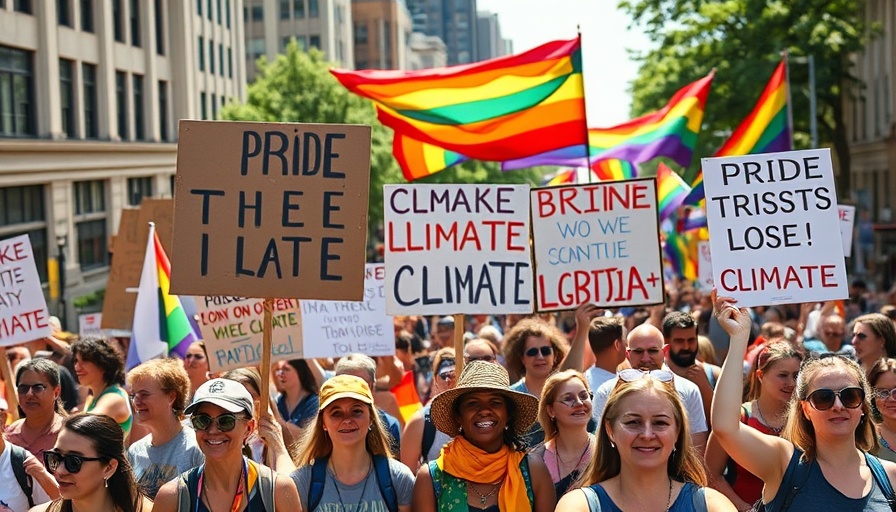
Understanding Climate Justice Through a Queer Lens
In a world facing mounting environmental challenges, the intersectionality of climate change and LGBTQIA+ rights has become an urgent topic of discussion, especially within vulnerable communities in the Philippines. Queer Filipinos are not only advocating for environmental justice but also addressing the unique challenges posed by climate change on their livelihoods and health. With natural disasters exacerbating existing inequalities, this community's fight for inclusion in climate discussions is crucial for the sustainability of both their lives and the planet.
Climate Change and Vulnerability in the Philippines
The Philippines ranks among the top countries most vulnerable to climate catastrophes. Frequent typhoons and rising sea levels are part of daily life for many Filipinos, impacting access to vital services such as healthcare and housing. For LGBTQIA+ individuals, these challenges are compounded by systemic discrimination that often leaves them at the margins of disaster response efforts. A recent study highlighted that natural disasters disrupt essential services, including HIV treatment and safe shelter options, leaving this community precariously exposed.
The Role of Artistic Expression in Advocacy
Activists like Ghillean Pranz Fegidero, who performs under the drag persona Celestia, have taken it upon themselves to elevate queer voices in high-stakes environmental discussions. By blending artistry with advocacy, they challenge conventions and bring attention to the pressing need for inclusive climate action. "Bringing my drag into the climate activism space is my love letter to the queer community," Celestia stated, underscoring how creative expressions can serve as powerful tools for advocacy.
Historical Context: Resilience Amidst Adversity
The resilience of LGBTQIA+ Filipinos is historically rooted, demonstrated through community-led efforts in disaster response and mutual aid. Grassroots organizations, often led by queer individuals, have become lifelines during crises, mobilizing resources and providing support when formal systems fail. This historical context emphasizes the importance of recognizing diverse voices in the climate movement.
Future Predictions: The Path Forward for Queer Climate Activism
Looking ahead, the demands for climate justice will intensify, necessitating the inclusion of marginalized voices, especially from the LGBTQIA+ community. As climate-related events become more frequent, queer activists are likely to play a vital role in shaping policies that are equitable and effective. Embracing a holistic approach that acknowledges unique vulnerabilities and fosters collaboration among diverse groups will be essential in constructing a more sustainable future.
Inspirational Quotes That Ignite Change
Activists from within the community have offered compelling insights that resonate well beyond their contexts. One statement stands out: "Drag is a form of protest against oppressive systems. It’s powerful – and we shouldn’t forget that.” Such sentiments encapsulate the essence of how artistic expression can serve as both a catalyst for change and a means of celebrating identity.
The Emotional Impact of Climate Uncertainties
For many within the LGBTQIA+ community, the emotional toll of climate change is profound. The fear of losing livelihoods and support systems due to increasing natural disasters often leads to anxiety and despair. However, this community’s resilience shines through as they draw on their historical strength to support one another, demonstrating solidarity in their fight for survivability and climate justice.
Conscious Living and Eco-Friendly Practices
As activists advocate for climate inclusion, there is a simultaneous push for more sustainable ways of living. Many queer Filipinos are integrating eco-friendly practices in their everyday lives, highlighting the importance of sustainable agriculture, reducing waste, and ethical consumerism. Advocates encourage community connections that center sustainability, helping to build stronger, resilient networks that can withstand the impacts of climate change.
Call to Action: Join the Fight for Climate Inclusion
The fight for climate justice is one that encompasses all communities, especially those that have been historically marginalized. Everyone has a role to play in advocating for inclusive policymaking that considers the vulnerabilities of the LGBTQIA+ community amidst climate change. Engaging in sustainable practices, supporting queer-led initiatives, and amplifying their voices in environmental conversations are crucial steps toward building a more equitable and just society.
 Add Row
Add Row  Add
Add 



 Add Row
Add Row  Add
Add 

Write A Comment